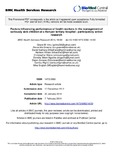| dc.description.abstract | Background
Implementation of World Health Organization case management guidelines for serious childhood illnesses remains a challenge in hospitals in low-income countries. Facilitators of and barriers to implementation of locally adapted clinical practice guidelines (CPGs) have not been explored.
Methods
This ethnographic study based on the theory of participatory action research (PAR) was conducted in Kenyatta National Hospital, Kenya?s largest teaching hospital. The primary intervention consisted of dissemination of locally adapted CPGs. The PRECEDE-PROCEED health education model was used as the conceptual framework to guide and examine further reinforcement activities to improve the uptake of the CPGs. Activities focussed on introduction of routine clinical audits and tailored educational sessions. Data were collected by a participant observer who also facilitated the PAR over an eighteen-month period. Naturalistic inquiry was utilized to obtain information from all hospital staff encountered while theoretical sampling allowed in-depth exploration of emerging issues. Data were analysed using interpretive description.
Results
Relevance of the CPGs to routine work and emergence of a champion of change facilitated uptake of best-practices. Mobilization of basic resources was relatively easily undertaken while activities that required real intellectual and professional engagement of the senior staff were a challenge. Accomplishments of the PAR were largely with the passive rather than active involvement of the hospital management. Barriers to implementation of best-practices included i) mismatch between the hospital?s vision and reality, ii) poor communication, iii) lack of objective mechanisms for monitoring and evaluating quality of clinical care, iv) limited capacity for planning strategic change, v) limited management skills to introduce and manage change, vi) hierarchical relationships, and vii) inadequate adaptation of the interventions to the local context.
Conclusions
Educational interventions, often regarded as `quick-fixes? to improve care in low-income countries, may be necessary but are unlikely to be sufficient to deliver improved services. We propose that an understanding of organizational issues that influence the behaviour of individual health professionals should guide and inform the implementation of best-practices. | en_US |


